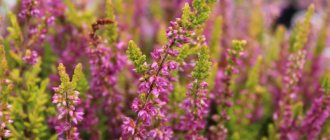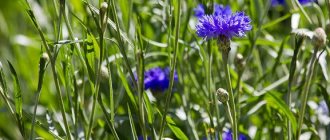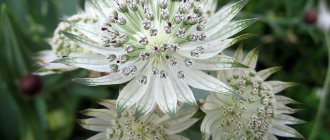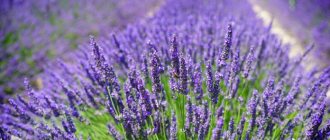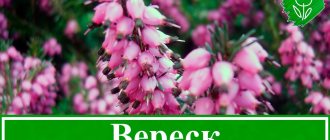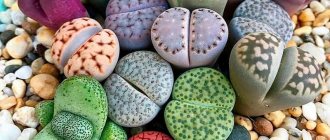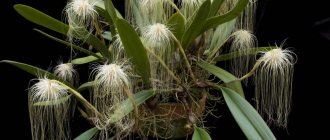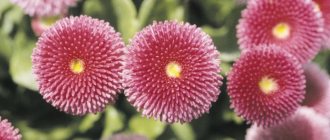In this material, we have collected everything a novice gardener needs to know about heathers, from the rules and timing of planting to the selection of beautiful varieties and the creation of spectacular flower arrangements.
Heather is an excellent honey plant that bees love. And this fact alone can be considered a strong argument to plant this flower in your garden. But this is far from his only advantage.
This plant is resistant to drought, heat and frost. It does not require complex care and hardly gets sick. In addition, heather reproduces easily. Not to mention that he is very handsome. There is something romantic and touching about this flowering bush.
If you decide to create a heather meadow in your garden, but don’t know which way to approach this matter, our article will come to your aid.
Botanical description
Common heather (Calluna vulgaris) is an evergreen, highly branched shrub 20-100 cm high. It has a creeping and erect form. Erect stems with leaves arranged in a stepped tiled pattern form a beautiful wide crown.
Heather leaves have no petiole and look like needles. They have a triangular shape. Their size is only 2.5 mm in length and up to 2 mm in width. Heather leaves are arranged in 4 rows.
Heather becomes most decorative after frost, when its leaves turn bright burgundy and yellow.
Heather is a long-liver. The lifespan of the plant reaches 45 years with annual flowering.
Where to plant
Heather does not tolerate transplantation well, so choose a location and prepare favorable soil in advance. Typically the plant lives in one place for about 20 years. The shrub is not picky about temperature and environmental conditions. Due to properties such as hardiness and drought resistance, the natural habitat of heather is Africa, North America, moderately cold areas of Europe, and the Alpine mountains at an altitude of 2500 m.
In the shade or in the sun
The plant loves semi-shaded and sunny places, but constantly shaded areas will not do it any good. This is due to the natural conditions for the reproduction of heather. Beautiful flowers bloom on a shrub that grows in direct sunlight. The less sun, the less attractive the blooms.
Choose a place well protected from wind and excessive humidity. If there is a risk of flooding, install drainage.
What soil to plant heathers in and how to prepare the soil for planting yourself
Heather loves acidic soil, so an alkaline and calcareous environment is not suitable for it. In the wild, the plant is common in poor soils, peat bogs and pine forests. For good growth, it is best to create the most similar conditions for the plant.
Loose, breathable soil is recommended. The most favorable is considered to be coniferous soil with decomposed particles of spruce, pine forest, and peat. Add particles of bark and sawdust from coniferous trees, or acidic peat (Ph 4–5) to the soil.
If you choose a low location, be sure to install drainage in a ratio of 1:3 to the soil. Without it, the root system rots due to excess moisture. For drainage, use expanded clay, sand, fine gravel, broken brick. This promotes good flowering.
Pharmacological properties
Heather provides:
- anti-inflammatory;
- antispasmodic;
- painkiller;
- enveloping;
- astringent;
- diuretic;
- expectorant;
- antimicrobial;
- disinfectant;
- soothing;
- wound healing;
- diaphoretic action.
The drug with heather is taken orally in the form of teas, tinctures, decoctions and infusions. Used externally to treat skin and inflammatory diseases, wounds and abrasions.
Heather tea
Planting and caring for heather
- Planting: sowing seeds for seedlings is carried out at the end of March (or at the beginning of April), and two years later, the grown seedlings are planted in the ground in the second half of April (or at the beginning of May), but it is still better to do this at the end of September (or at the beginning of October).
- Flowering: July-August.
- Lighting: bright sunlight or light partial shade.
- Soil: wet peat or dry sandy soils with a pH of 4.5-5.5. Heather is not grown in limed soils.
- Watering: once every one and a half to two weeks.
- Humidity: higher than usual. In hot weather, the plant requires evening spraying.
- Feeding: in April or May with complete mineral fertilizer.
- Reproduction: by dividing the bush, apical cuttings, layering and seeds.
- Pests: practically not affected.
- Diseases: gray rot, powdery mildew, rust, viral infections.
- Properties: heather grass has wound-healing, cleansing, anti-inflammatory, diuretic, expectorant, disinfectant, anti-acid and soothing properties.
Read more about growing heather below.
Indications for use
Due to its complex effects on the body, heather is used in the treatment of a wide range of diseases.
Most effective for colds and inflammatory diseases. It is prescribed for the treatment of complex pneumonia, tuberculosis, and rheumatism. The plant is part of medicinal stomach, kidney, sedative, cold, and antiallergic preparations.
The plant is prescribed for:
- Skin diseases and inflammations of the mucous membranes:
- allergic rashes;
- furunculosis;
- eczema;
- psoriasis;
- trophic and other ulcers;
- stomatitis;
- angina;
- periodontal disease, etc.
- Gastrointestinal diseases:
- gastritis with high acidity;
- stomach and duodenal ulcers;
- heartburn;
- dysbacteriosis;
- pancreatitis;
- cholecystitis;
- hepatitis of various forms;
- to increase appetite.
- Diseases of the kidneys and urinary tract:
- stones in the ureters and kidneys;
- cystitis;
- inflammation of the prostate;
- urethritis;
- pyelonephritis.
- To restore metabolism in diabetes, obesity, atherosclerosis.
- For pneumonia, bronchitis, cough of various etiologies.
- ENT diseases:
- tracheitis;
- laryngitis;
- pharyngitis;
- sinusitis;
- rhinitis and others.
- In complex therapy of oncology.
- For neurological problems and in cases of depression, nervous tension, insomnia.
Heather has a general strengthening effect, improves immunity. When taking medications containing plant extract, nails and hair are noticeably strengthened and skin condition improves.
Improves hair condition
At what distance should heather be planted from each other?
Heather does not like transplanting, so prepare the soil in advance. The area that the shrub will occupy depends on the variety chosen. To get your bearings, count on a distance between bushes of 20–60 cm. Thus, up to 10–15 small varieties of plants, and a maximum of 8 heather bushes of large species, can be placed per 1 sq. m.
Bush planting scheme.
If you plant the seedlings too densely, after 1–2 years the plants will be crowded. You will not be able to get a large beautiful crown. More sparse planting does not harm the heather. The plant reproduces actively and likes to survive other plants in the area. Therefore, monitor this process annually, otherwise only heather will remain in the garden.
Contraindications for use
No side effects were found for drugs containing heather. However, there are contraindications.
- In case of individual intolerance to the plant.
- Not recommended for use by pregnant and lactating women. This is due to the high content of essential oils.
- Due to its tonic effect, heather is contraindicated in severe psychoneurological disorders.
- For patients with gastritis with low acidity, preparations with heather are strictly prohibited. They tend to reduce acidity and coat the mucous membrane, which is unacceptable in the hypoacid form of the disease.
What plants can heather be planted with?
Heather gets along best with plants that love the same acidic soil. These are mainly low-growing shrubs (Thunberg barberry), herbs (Masus repens), flowers (grass carnation, Amur carnation, eight-petalled dryad), as well as small coniferous trees and ferns. In decorative design, landscapers in central Russia often use compositions of heather with azalea or rhododendron.
Heathers in landscape design.
Features of heather
Heathers are unpretentious plants and can be found everywhere. With the exception of steppes and deserts. In tropical climates they grow in highlands.
Due to the microscopic size of the seeds, heather is carried by the wind over enormous distances, 100 kilometers or more. Scientists have proven an interesting fact: seeds from Sweden were carried by the wind to the Jutland Peninsula.
Heather plants form unusual communities - heathers. They are dense thickets in the center of which there is a bare space - heather. Such areas are formed due to the special arrangement of flowers and one-sided seeding of the soil.
When planting on personal plots, it is worth considering that other plants will not be able to grow in the area where heather grows. As it grows, it quickly conquers space. The advantage of this plant is that it can take root and live in any soil. It can be found even on mountain slopes, on rocky soil.
Heathers
Use in landscape design
Heather gardens decorate the site at any time of the year. They look especially impressive next to stones. One of the most successful plants in rock gardens and rockeries.
Heathers in a rocky garden
When creating an artificial relief, stones are laid so as to form horizontal platforms, pockets, and terraces. Bushes are planted in them as if they were growing on a flat surface. Then, when watering, the water does not flow down the slope, but lingers around the bush.
Heathers are usually planted separately from other ornamental plants, due to the special soil substrate in which only representatives of this family grow. This makes it easier to care for plants. In addition, a certain style is formed, which makes no sense to mix with inappropriate plants.
The most successful neighbors for heather are rhododendron, andromeda, and Erica.
With their help, they create a garden of continuous flowering. In spring, andromeda and erica bloom, then they are replaced by rhododendron. And after a short break, small heather buds bloom and decorate the garden until frost.
With proper planting and care, heathers will decorate the garden at any time of the year.
Main types and varieties
There are many varieties of heather. All of them are divided into groups depending on the color of the foliage and the shape of the flowers.
Varieties with green foliage
- Allegro
It has a crown up to 50 cm in size.
The bark is brown. The leaves are dark green.
Flowering period from late July to late October with red glossy flowers.
- Darkness
Low-growing shrub, up to 35 cm tall, with a dense compact crown.
The leaves are light green in summer and darken in winter.
The flowers are small purple.
Flowering period: August – October.
Prefers peaty, acidic soil.
- Marlene
Representatives of this variety grow up to 70 cm. The crown is wide, up to 50 cm in diameter.
It blooms with bright purple flowers from August until late autumn.
Winter-hardy.
- Scottish heather
Refers to the tall ones. Reaches a height of 1 m. The crown is wide.
It differs from other representatives of the Heather genus in its bright red-brown bark.
Heather Allegro
Heather Darkness Heather Marlene
Scottish heather
Varieties with white flowers and green leaves
White flowers in heather are rare. It does not occur in nature at all.
- Variety Long White
A low-growing shrub 20-40 cm tall with a dense, bizarre crown.
It has long narrow leaves of lush green color and dark brown bark.
Small white flowers form large, oblong, 25-30 cm inflorescences.
Frost-resistant. Grows best in sunny areas. Needs regular watering and pruning.
Bred in Holland.
- Hamondi
A shrub 40-70 cm high and with a spherical crown with a diameter of 50 cm.
It grows slowly. The leaves are small, scale-like.
Flowers are collected in clusters reaching 20 cm.
Bred in England.
- Alba
An erect bush 40 cm tall and a crown of 50-60 cm.
White flowers form large dense clusters.
Variety Long White Heather Hamondi Heather Alba
Varieties with silver foliage
Heather is decorated not only by flowers, but also by leaves. For example, with a silver color.
- Veresk Silver Knight
Low growing variety.
Deflected branches form a wide crown.
The flowers are purple or lilac, solitary. Collected in long brushes.
Blooms September–October.
- Ian Dekker
The height is only 15 cm with a crown diameter of 30 cm.
The branches are raised. We bloom in September with pink-lilac inconspicuous flowers.
Heather Silver Knight
Heather Jan Dekker
Varieties with golden foliage
There are also varieties with golden foliage. All of them are light-loving and frost-resistant. But in harsh winters it is recommended to cover them.
- Orange Queen
A spherical shrub, up to 60 cm wide and high.
The bright green foliage turns yellow or orange by late August. In winter it takes on a copper and orange-red color.
In August, soft pink flowers are added for decoration, which last until November.
- Aurea
The shrub is low.
Leaves are needle-shaped, opposite. In summer it is yellow-golden in color, which changes to burgundy or brown in winter.
The peculiarity of the variety is vertically located large light purple inflorescences. Flowering is long-lasting, from early August to late October.
Heather Orange Queen
Heather Aurea
Varieties with double flowers
Heathers with double flowers require more attention and care. But they will be rewarded with lush and long-lasting flowering of the bush.
- Belle
It is considered one of the most beautiful varieties.
A shrub 30-50 cm tall with gray-green leaves covered with a huge number of double flowers in pale pink shades.
- Alporti
A fast-growing representative of the Heathers, more than 60 cm high.
The leaves are pubescent, bright green.
The flowers are purple or lilac, double.
Notable for being a symbol of Norway.
- Alba Plena
The only variety with double white flowers.
Blooms September-October.
Grows up to 40 cm.
Heather Bel
Heather Alporti Heather Alba captivity
Varieties with unopened flowers
A feature of a number of heather varieties is their flowers that do not open.
- David Eason
A spherical shrub 20 cm in diameter.
It has a large number of lateral branches with dark green leaves. Dark pink flowers are collected in small inflorescences and do not open even during flowering.
- Fritz Kircher
The bush reaches a height of only 30 cm and a width of 45 cm. The branches are directed upward.
Red-pink flowers do not open.
- Minima
Small shrub 5 cm tall and 15 in diameter.
The leaves are green in summer and turn brown in winter.
Bright pink flowers are collected in short brushes. Non-expandable.
Heather David Eason
Heather Fritz Kircher
Heather Minima
Heather in the garden: planting
Heather is a beautiful, tender and delicate plant. It definitely deserves pride of place in the garden! Fortunately, creating heather on your site is not that difficult. The main thing is to know the features of planting and caring for heather.
Where and when to plant heather
Like most perennials, heather can be planted in early autumn or late spring, when frosts have not yet begun or have already subsided. If you live in a region with harsh winters, it is preferable to postpone planting this plant until spring - this way it will definitely take root and take root well.
When heather is propagated by dividing the rhizome, transplantation is carried out in August.
Well-lit areas are chosen for planting. This crop needs at least 6 hours of sunlight daily. In bright light, the heather acquires a rich color, and in the shade it fades.
Soil mixture for heather
This plant loves areas with acidic soil - pH 3.5-5.5. On alkaline, calcareous soils, heather will simply die.
An ideal soil mixture consists of peat, soil from a coniferous forest, sand and sawdust (3:1:1:1). In this case, coniferous soil is taken from a depth of 5 cm in a pine or spruce forest.
If you use high-moor peat to prepare the soil mixture (it is red, brown or brown), you do not need to add sand.
For 1 cubic meter of mixture, 70 g of sulfur can be added as fertilizer.
How to plant heather
First of all, prepare a place for planting heather. Considering that this crop needs a special soil composition, remove the top layer of soil to a depth of 1 spade and pour the prepared soil mixture into the resulting hole. After this, lightly trample the ground and water it with water acidified with 6% apple cider vinegar (100 g per 10 liters of water).
Next, you need to mark the planting holes. When planting, it is important to consider that this plant reproduces well by layering, so a good distance should be maintained. Heather is planted no closer than 60 cm from other shrubs, and at a distance of 40-50 cm from each other, to prevent shading and ensure good air circulation near the roots.
The size of the planting hole depends on the size of the seedling. Follow this rule: the width of the hole should be twice the width of the root ball, and the depth should be equal to its length.
If the soil on your site is heavy, it is advisable to play it safe and pour a layer of drainage 2-3 cm thick on the bottom. Pebbles, expanded clay, perlite, and broken brick are suitable.
Next, the heather roots are straightened horizontally at the bottom of the hole and covered with substrate to the level of the root collar of the seedling (the place where the root system passes into the above-ground part). After this, the soil is slightly compacted and, if necessary, watered a little more.
It is advisable to mulch the roots with conifer bark, peat or sawdust. The first option is preferable, since the bark of pine and spruce contains mycorrhizae - symbiotic relationships formed by fungal mycelium, which heather needs for good growth.
Heather can also be grown in containers.
Application
Heather is in demand in many areas.
In medicine
In folk medicine, heather is considered a remedy for many diseases. Whereas it is not recognized in official pharmacology in Russia.
In the West, heather is prescribed for treatment in medical institutions.
In cooking
Heather is used to prepare delicious culinary dishes: jellies, drinks, mousses. It is ideal for flavoring wines and liqueurs.
In gardening
There is no better plant for alpine slides than heather. It is unpretentious, not picky about soils and conditions.
You can make beautiful compositions from it by planting varieties with different colors of flowers and leaves, selecting them by height and width.
Heather in gardening
In beekeeping
Heather is a honey plant. The honey it produces is thick, with a slightly noticeable bitterness and very aromatic.
It contains a large amount of protein and minerals.
Heather honey does not crystallize, but becomes jelly-like. This is due to the unique composition of micro and macroelements.
How to properly plant heather in open ground at your summer cottage
To successfully plant heather, it is necessary to create conditions as similar as possible to those in which it reproduces in the natural environment. The climate of central Russia is most favorable for active plant growth. Acidic, loose soil is suitable for it. The alkaline and calcareous environment does not allow the shrub to take root properly. Consider this point when choosing a landing site.
Seedlings in the fall to overwinter
Planting heather in autumn is recommended exclusively for central Russia, where winter frosts are not too severe. Only here will it be possible to preserve an unrooted plant until spring. Otherwise, the immature root system will not withstand the cold and the plant will die, even if the young bush is covered and insulated.
If the height of the seedlings is less than 2 cm, planting in open soil in the fall is prohibited. In this case, place the seedlings in pots and keep them at home until spring.
in spring
Heather seedlings are planted in the spring after the soil has warmed up. Shrubs should not be planted immediately after frost. The roots of the plant will die because they will not be able to take root and receive enough nutrients.
In central Russia, plant the plant in late April - early May. If we are talking about more northern regions, landing is possible from mid-May. This will allow the heather to take root deep enough before the onset of cold weather, which will protect the bush from damage.
Growing heather from seeds
Growing heather from seeds is a long and painstaking process. Their germination rate is excellent and is 90%. The seeds do not retain the characteristics of the mother plant.
For sowing, soil is prepared from sand, peat and coniferous soil in a ratio of 1:2:1.
The seeds are distributed over the surface of the pre-moistened soil mixture without deepening them.
Then cover with glass and place in a warm place. It is necessary to ensure that the seeds are in a moist environment.
The first shoots appear no earlier than after 4 weeks. And it is recommended to start hardening them immediately. To do this, the container is placed in a cooler place and the glass is removed for a while, gradually increasing it.
Heather seeds
What time does disembarkation take place?
After the seedlings grow, they are picked and planted in individual containers.
Seedlings need systematic watering. Do not allow the soil to dry out, as this will lead to the death of the seedlings.
Watering
In summer, seedlings are taken outside to a semi-dark place. With the onset of cold weather, they are transferred to a cool room, 10-12°.
Planting heather in open ground
It is recommended to transplant heather to a permanent place, in open ground, at 2 years of age. This is done in the spring, at the end of April - beginning of May. You can do this in the fall, but in this case the survival rate of plants is noticeably reduced.
It is better to choose a sunny site. But, given the unpretentiousness of heather, it can be planted anywhere, regardless of the light level and soil composition. The only condition is that heather does not grow in calcareous soil.
It is advisable to provide protection from the wind and add high-moor peat to slightly acidify the soil.
6-10 plants are distributed per 1 square meter, depending on the variety. The bush is buried so that the root collar is at the level of the soil surface.
In clay soil, make a 5-10 cm drainage layer of sand or broken brick. It wouldn’t hurt to add 20-30 grams of nitrophoska to each hole.
After planting, the heather is watered with 5-6 liters of water per bush. The row spacing is mulched with peat or sawdust, and coniferous bark.
Planting heather in open ground
Features of care
For beautiful, lush and long-flowering bushes, it is important to maintain soil moisture levels. The heather root system is short, so it needs frequent, abundant watering. To protect the soil from drying out and overheating, the area with heather is sprinkled with a thick layer of mulch.
After watering, the soil is loosened and weeds are removed. They do this in such a way as not to remove the mulch.
During particularly hot summer periods, it is recommended to spray heather in the evening.
Feed the heather in the spring with complex mineral fertilizer. It is scattered under the bushes, avoiding contact with leaves, buds and flowers. Otherwise, a burn may occur. After sprinkling with fertilizer, the area is watered generously.
If necessary, pruning is done in the spring to form bushes and stimulate the growth of new shoots.
Mulch
Pests and diseases
The plant is resistant to many diseases and pests. But there are a number of viral and fungal diseases that affect heather. The protection is weakened by stagnation of liquid in poorly permeable, heavy soil.
In case of damage, a gray coating appears on the bush, which quickly spreads. Then parts of the plant die off. At the first signs, the plant should be treated with a fungicidal solution. For severe damage, use copper sulfate in a 1% solution.
Treatment occurs three times every 5-7 days.
For prevention purposes, it is recommended to treat with fungicides in the fall, when preparing plants for winter, and in the spring, immediately after the snow cover melts.
Heather propagation
It is possible to increase plantings not only through sowing seeds. The bush propagates by division, cuttings and layering.
- The tops are cut off from strong flowering branches and planted in a moistened mixture of peat and sand. The pot is placed in a cool place.
- Cuttings must be fed with a urea solution (1 g per 1 liter of water) or microfertilizers. They do this once every 2 months.
- In spring, rooted cuttings are planted in a permanent place.
- Heather tends to take root by layering. Old branches lie on the ground and roots form on them.
- If you bend the stem and pin it to the ground, you will end up with a strong layer. To stimulate and accelerate root formation, the place of contact with the ground is sprinkled with a layer of peat.
- The cuttings will be ready for separation and transplantation in a year.
Dividing the rhizome is the easiest way to propagate heather. To do this, at the end of summer, dig up a large, mature bush and cut the roots so that each separated part contains roots and young shoots. The cut areas must be sprinkled with crushed coal to prevent rot. Old stems are cut off.
Rhizome division
Heather after flowering
In order for the heather to please next season, it needs to be prepared for winter. In warm climates, it tolerates winter well without any additional action. But during frosty or little snowy winters, the plant needs shelter.
When the first frosts occur, the soil is mulched with peat and the plantings are covered with spruce branches. It will protect against low temperatures and prevent sunburn in early spring. In April, the shelter must be removed.
Cover with spruce branches
Procurement of raw materials
In heather, the above-ground part of the plant is considered medicinal. The favorable period for harvesting is August – September, during the peak of flowering.
- The stem is cut with pruning shears and laid out to dry in a thin layer on fabric or paper in the shade, or hung, tied in small bunches. The place should be well blown by the wind.
- After drying, the plant is shaken. Leaves and flowers fall. They are used to prepare dosage forms. The inflorescences are of the greatest value.
- The roots are rarely used to prepare medicinal baths. They are harvested at the end of October – beginning of November.
- The rhizomes are thoroughly washed from the ground, dried in the open sun and laid out in the shade until completely dry.
- Dried raw materials are laid out for storage in fabric bags or paper bags in a dark room.
Procurement of raw materials
Trimming
Pruning is a very important part of the growth and maturation of a shrub. Formative pruning of shrubs should be carried out no more than once a year. The procedure is carried out after the flower buds have already faded and began to gradually fade.
It is worth noting that pruning is also carried out before the plant begins a period of active growth, or vice versa, immediately after the end of the period.
Formative pruning helps maintain the beautiful appearance of the shrub, delaying aging and helping it bloom again. An important detail is the location of the pruning. The procedure is permissible only on the green part of the bush. It is the softest, has not yet had time to “grab” and gain strength.
If you trim a bush in places where the branches have already hardened, it may well die, because it will not be able to form new shoots in those places due to their woodiness. To maintain the natural appearance of the bush, it is necessary to shorten the branches at different lengths. This will allow you to maintain a natural, careless image.
Diseases and pests
Too wet soil and air can lead to late blight, a fungal disease.
The bush becomes covered with a gray coating, young shoots bend away from the main plant and die, the plant sheds its leaves.
How to treat late blight:
- remove infected branches;
- treat the bush with 1% copper sulfate;
- dilute the drugs Topaz or Fundazol as indicated in the instructions;
- treat the bush three times a month.
For preventative purposes, treat all heathers in early spring or late autumn.
Heather can get sick with another fungal disease - powdery mildew.
A light gray coating and spots of the same color appear on the shoots and leaves, which begin to dry.
How to treat powdery mildew: spray the bushes with Bayleton, Topaz, Topsin, Fundazol or some other antifungal drug.
Despite the good resistance of heather to viruses, it can still become infected. If the leaves and flowers begin to change color and become deformed, it means that a virus has occurred.
How to treat the virus: Dig up the affected plant and burn it to prevent the virus from spreading throughout the garden.
The main pest that settles on the heather bush is the scale insect. It sucks all the juices out of the plant, it withers and eventually dies.
How to deal with scale insects:
- spraying with soap solution;
- spraying with insecticides.
Heather can get sick if it doesn’t like the place it grows, for example, too wet soil, stagnant water, “overfeeding” with mineral fertilizers and organic matter.
The foliage changes color to brownish, young shoots become dull.
This situation can be corrected by transplanting the heather to another, more suitable place, and watering the soil on which it grew with a dark solution of potassium permanganate.
To make it easier for you to understand growing heather, below are answers to frequently asked questions.
Reviews from gardeners growing heather on their property
Maria, 53 years old
I bought Heather by accident. I just liked the look. I started reading at home about what to do with it, and realized that there would probably be another dried flower in the flowerbed. Everything seemed so complicated. But she dropped me off anyway. He survived a winter, then a drought, then another winter. Now I have already planted it and grown into half the garden. I also bought different types. Blooms from late June until winter. Beauty.
Mikhail, 48 years old
A few years ago we finally moved into our house and the question arose of improving the area. There is a problem. The soil is acidic. This narrowed our design options. My wife ordered various seedlings on the Internet, and we got to work. Everything was planted in the fall. There were trees and bushes there. I was worried about how they would survive the winter. Our frosts are severe. Everything took root. Even heathers. Even though I thought the frost would kill them, they were planted too late. 3 years have passed, there are already shoots. Blooms well. The wife is happy.
Ekaterina, 62 years old
I saw heathers at my neighbor's place. They bloom so beautifully. For six months. I asked for a few branches when she was seating them. I had to dig around a bit, it turns out that the soil there is not so easy, it needs to be oxidized. But fortunately, the stores now have everything. I don’t have a plantation yet, but everything is ahead. They don’t need anything except fertilizer now. This can be planted.
Traditional medicine recipes
The powder of the plant's flowers helps with skin diseases. To treat diseases of the throat and oral cavity, diseases of the nervous system, a decoction is used: place 20 g of heather in a 200 ml container, pour boiling water. Place the mixture in a water bath for 15 minutes, then leave for 3⁄4 hours and strain. Heather tea (1 tsp/200 ml of water) with the addition of honey helps eliminate insomnia and nervous tension.
For pulmonary tuberculosis, heather tincture is used. Tincture recipe: pour 10 g of plant roots with 50 ml of 70% alcohol, leave for 2 weeks. After straining, take 40 drops (less than a teaspoon) before eating.
Baths with heather infusion also have a calming and relaxing effect.
Useful bonuses
I think it’s no secret that heather is used as a medicinal plant. There is another pleasant feature - this plant is an excellent source of honey for bees, and autumn honey.
- Castor bean: planting, growing, care and maintenance at home and outdoors (115 photos and videos)
Bergenia - tips for properly growing a medicinal plant. Features of collection, application and contraindications (130 photos and videos of planting in the ground)
- Cloudberries: beneficial properties, features of cultivation and use. Planting, care and propagation with your own hands (150 photos and videos)
At this time, almost all plants have already stopped blooming, and therefore thick and mineral-filled heather honey will be a great bonus for beekeepers.
Care
If you want to see blooming heather at the right time, then you should pay due attention to the care and maintenance of the plant. As previously mentioned, there are no special requirements here, but those that exist should be observed.
For starters, the moisture level. Recently, the summer period has been very hot, which also affects the plants.
Heather has a fairly compact root system, in which there are many individual small branches. Its peculiarity is the need for moisture, which is found in the top layer of soil. To do this, you need to make sure that it remains moist, at least at night.
The air in summer is also dry, which can be compensated for by simply spraying with water. Again, this should be done in the evening, and it is better to take warm water, or at room temperature.
Despite the fact that heather is an unpretentious plant in special conditions, it should not be allowed to be adjacent to weeds. To this it is worth adding a slight loosening of the soil around the bush.
Once a week you can add mineral fertilizers to the water with which you water the heather - this will have a very positive effect on the appearance of the plant.
- Kitchen accessories: examples of modern options + instructions on how to choose
Maryin root: planting, care, cultivation, medicinal properties and characteristics of the plant (140 photos)
Monarda: types, varieties, planting in open ground, care and cultivation with your own hands (155 photos and video tips)
